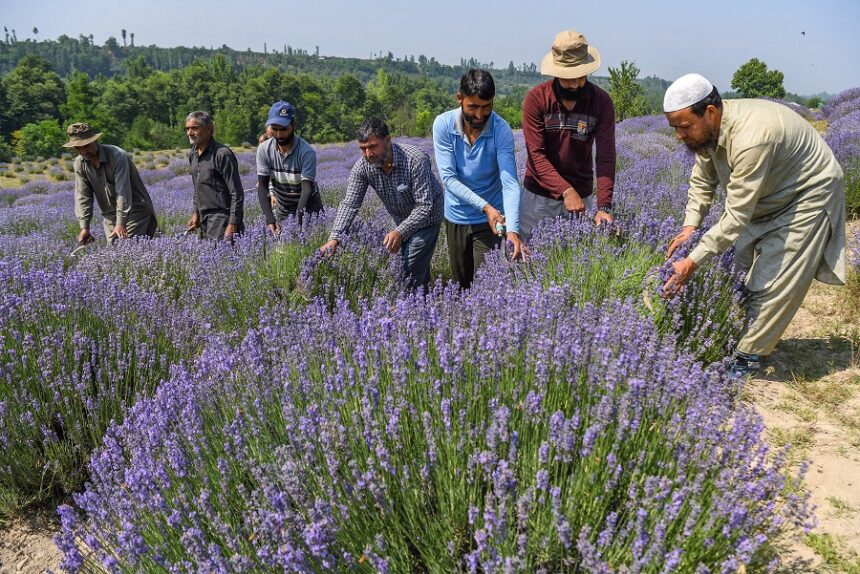Kashmir is perceived as the hub of medicinal plants. Lavender, particularly, shows promising potential as a therapeutic and aromatic herb that can positively contribute towards India’s and Kashmir’s economic and medical prospects.
The valley’s lavender is captivating both domestic and international markets. Findings have indicated that lavender farming can prove profitable for farmers given a sustained demand and organized farmer activities. To boost lavender production and export, the Government of India has been taking transformational steps.
In an interview with Rising Kashmir Director Agriculture Kashmir, Chowdhary Muhammad Iqbal said that the idea behind the promotion and introduction of lavender crop to newer areas on commercial lines is to create employment opportunities for the youth.
He stated that, as part of the Holistic Agriculture Development Program (HADP), the J&K Government has approved a project focused on the promotion of oil seeds, which is one of 29 initiatives.
“We are going to prepare more and more lavender planting material. People can use the planting material in the waste land, orchards, bunds and other places,” he said.
Iqbal said that lavender does not require much water, helps prevent soil erosion, and does not need many nutrients.
“We are working towards making lavender a significant part of entrepreneurship in the coming years. There are many government farms where we produce planting material,” he said.
The agriculture department aims for lavender to take its rightful place in the industry and encourages youth to join, as it will create job opportunities for them.
The director said last year Kashmir valley extracted 700 kgs of lavender oil and they are working hard to increase its production further.
“We are also coming with a Farmer Producer Organization (FPO) that will facilitate the farmers and will help in production and marketing the produce,” he said.
Regarding the purple revolution of lavender cultivation he said the credit goes to the whole agriculture department. The director said lavender is one of the best cash crops in the world. “The department will continue its promotion for lavender in the Himalayan region,” he said.
Chowdhary said the department has framed many policies to cultivate the best quality lavender in the valley and it will be improved further in coming years.
He said the demand for quality planting material of lavender in Kashmir division has increased over the years and efforts are on to meet the demand to attract progressive agriculture entrepreneurs towards this aromatic crop.
Last year the Jammu and Kashmir government approved a project on promotion of oil seeds worth Rs ₹31.00 cr and its implementation is expected to bring a major change in the floriculture sector.
Officials said India is the largest importer of vegetable oils in the world followed by China and USA. They said the total requirement of edible oils in UT is 14.30 lakh quintals, whereas the UT produces only 3.36 lakh quintals. Production is not commiserate with huge demand for edible oils.
As per HADP project details there is no availability of a suitable high yielding and hybrid varieties and there are poor facilities for marketing and value addition adding that the sector also suffers because of poor oil extraction technology and low efficiency of processing.
The lavender cultivation has employed large numbers of farmers and young entrepreneurs in the geographically remote regions of Jammu and Kashmir.
The CSIR-aroma Mission has been instrumental in promoting lavender cultivation in the temperate regions of Jammu and Kashmir. Its primary goal is to increase the income of small and marginal farmers and foster the development of agriculture-based startups.
The Purple Revolution or Lavender Revolution, launched by the Ministry of Science & Technology, aims to promote the indigenous aromatic crop-based agro economy through the ‘aroma mission’ of the Council of Scientific and Industrial Research (CSIR).
The mission aims to increase the income of the farmers and promote lavender cultivation on a commercial scale. Lavender oil, which sells for, at least, Rs. 10,000 per liter, is the main commodity. Other popular products include medicines, incense sticks, soaps, and air fresheners.
The cultivation of lavender is very cost-effective as it yields a revenue immediately. Jammu and Kashmir climatic conditions are conducive to lavender cultivation, since the aromatic plant can withstand both chilly winters and pleasant summers.
Additionally, it is a low maintenance crop, which can be used from its second year of plantation and blossoms for fifteen years. In its entirety, lavender production gives better returns when compared to other traditional crops.
In November last year, the Agriculture Department in Jammu in a significant move established a first of its kind lavender farm in Jammu province which is spread over 40-kanals of government land and it is expected to push the lavender sector and the cultivation.
The lavender farm is spread over 40 kanals of land, and is owned by the Department of Agriculture Production and Farmers’ Welfare Kathua.
Officials said the government’s ownership of a lavender farm aims to increase awareness of lavender cultivation within the local farming community. This initiative serves as a model for an alternative income source, contributing to the upliftment of the regional economy.
They said that the establishment of the farm would become a valuable source of quality planting material for farmers in the adjoining Bani and Duggan Blocks, with the potential to supply saplings to other areas in the Union Territory of Jammu & Kashmir.
The CSIR-Aroma Mission is a flagship project of CSIR under which Lavender cultivation is being promoted in the temperate regions of J&K. The aim of the project is to increase the income of small and marginal farmers and develop agriculture-based Startups.









